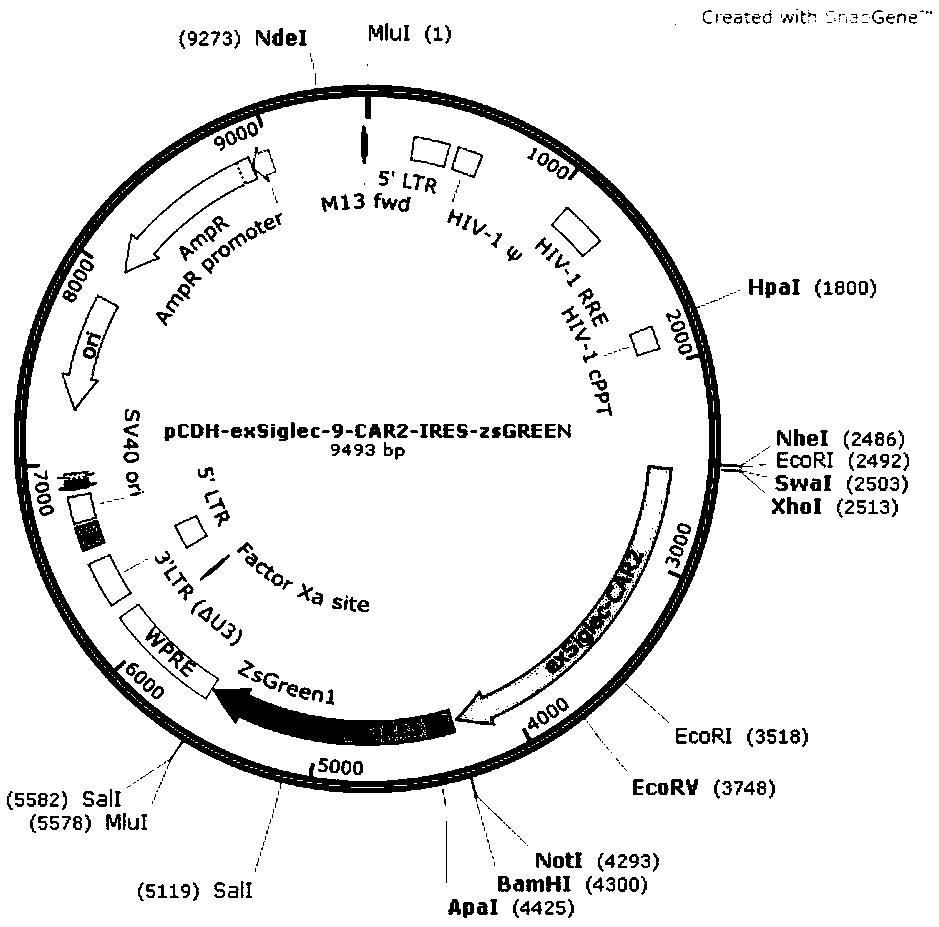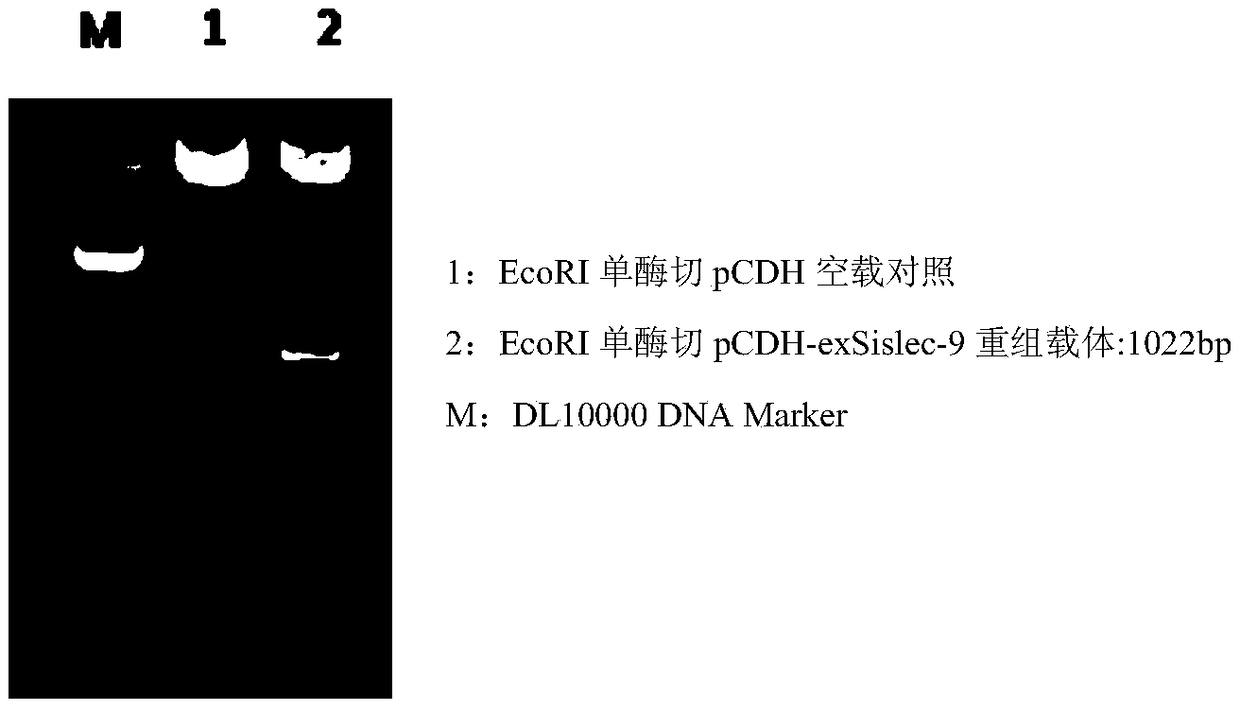Siglec-9 targeted embedding antigen receptor T cell and purpose thereof
A chimeric antigen receptor, host cell technology, applied in receptors/cell surface antigens/cell surface determinants, polypeptides containing localization/targeting motifs, animal cells, etc., can solve the unsatisfactory treatment effect And other issues
- Summary
- Abstract
- Description
- Claims
- Application Information
AI Technical Summary
Problems solved by technology
Method used
Image
Examples
Embodiment 1
[0185] Example 1 Obtaining Siglec-9 Extracellular Gene Sequence
[0186] The present invention screens an extracellular segment gene sequence from Siglec-9 full-length gene sequence through a large number of screening. The primers were designed with SnapGene software and synthesized in the company. Using the cDNA of the NK-92 cell line as a template, the extracellular segment of Siglec-9 was amplified by RT-PCR, and the RT-PCR product was sequenced to obtain the extracellular segment of Siglec-9 The sequence is as follows:
[0187] ATGCTGCTGCTGCTGCTGCCCCTGCTCTGGGGGAGGGAGAGGGCGGAAGGACAGACAAGTAAACTGCTGACGATGCAGAGTTCCGTGACGGTGCAGGAAGGCCTGTGTGTCCATGTGCCCTGCTCCTTCTCCTACCCCTCGCATGGCTGGATTTACCCTGGCCCAGTAGTTCATGGCTACTGGTTCCGGGAAGGGGCCAATACAGACCAGGATGCTCCAGTGGCCACAAACAACCCAGCTCGGGCAGTGTGGGAGGAGACTCGGGACCGATTCCACCTCCTTGGGGACCCACATACCAAGAATTGCACCCTGAGCATCAGAGATGCCAGAAGAAGTGATGCGGGGAGATACTTCTTTCGTATGGAGAAAGGAAGTATAAAATGGAATTATAAACATCACCGGCTCTCTGTGAATGTGACAGCCTTGACCCACAGGCCCAACATCCTCATCCCAGGCAC...
Embodiment 2
[0188] Example 2 Construction of pCDH-exSiglec-9-CAR2-IRES-zsGREEN vector
[0189] The extracellular segment sequence of Siglec-9 obtained in Example 1 and the second-generation CAR sequence (CD8-CD3zeta-4-1BB) that have been constructed by our laboratory were linked together by overlapping PCR. The exSIGLEC-9-CAR2 sequence was ligated to the PLVX vector by means of restriction enzymes XhoI and XbaI. Then the exSIGLEC-9-CAR2-IRES-zsGREEN sequence on the PLVX-exSiglec-9-CAR2-IRES-zsGREEN vector was digested with BamH I and SalI and connected to the PCDH vector.
[0190] The specific method is as follows: First, cut the PLVX-exSiglec-9-CAR2-IRES-zsGREEN vector with XhoI and XbaI to recover the exSIGLEC-9-CAR2-IRES-zsGREEN fragment, then fill in the sticky ends with Klenow enzyme, and then use CIP enzyme Remove phosphorylation. At the same time, the empty pCDH vector was digested with BamHI and Sal I to recover large fragments. The sticky ends were also filled in with Klenow enzyme,...
Embodiment 3
[0193] Example 3 Virus packaging
[0194] PCDH and PCDH-exSiglec-9-CAR2-IRES-zsGREEN plasmid amplification and virus packaging
[0195] 3.1 Plasmid transfection
[0196] 1) Place the plasmid, PEI, and Opti-MEM medium at room temperature for 5 minutes;
[0197] 2) Take 436μl of Opti-MEM in a 1.5ml EP tube, add 64μg PEI to mix, and let it stand at room temperature for 5 minutes;
[0198] 3) Take 12μg of vector plasmid PCDH and PCDH-exSiglec-9-CAR2-IRES-zsGREEN, 8μg psPA×2, 4μg pMD2.G, add Opti-MEM to 500μl, and let stand at room temperature for 5min;
[0199] 4) Add the prepared PEI-Opti-MEM solution to the Opti-MEM containing the plasmid, and let it stand at room temperature for 20 minutes;
[0200] 5) Slowly drip 1ml DNA / PEI mixture into the 293T petri dish laid the day before, mix gently, incubate at 37°C incubator, change the fresh medium after 6-8h, and put it in 37°C incubator to continue incubating .
[0201] 3.2 Virus collection and concentration
[0202] 1) 48 hours after plasmid tr...
PUM
 Login to View More
Login to View More Abstract
Description
Claims
Application Information
 Login to View More
Login to View More - R&D
- Intellectual Property
- Life Sciences
- Materials
- Tech Scout
- Unparalleled Data Quality
- Higher Quality Content
- 60% Fewer Hallucinations
Browse by: Latest US Patents, China's latest patents, Technical Efficacy Thesaurus, Application Domain, Technology Topic, Popular Technical Reports.
© 2025 PatSnap. All rights reserved.Legal|Privacy policy|Modern Slavery Act Transparency Statement|Sitemap|About US| Contact US: help@patsnap.com



